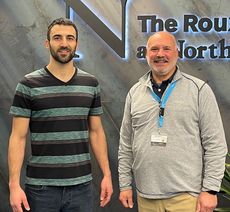
Processing Your Payment
Please do not leave this page until complete. This can take a few moments.
- News
-
Editions
View Digital Editions
Biweekly Issues
- December 15, 2025
- December 1, 2025
- Nov. 17, 2025
- November 03, 2025
- October 20, 2025
- October 6, 2025
- + More
Special Editions
- Lists
- Viewpoints
-
Our Events
Event Info
Award Honorees
- Calendar
- Biz Marketplace
NASA will fund testing of rocket engine parts made with 3D printing
 Courtesy / bluShift Aerospace
bluShift Aerospace founder Sascha Deri views a prototype rocket test in early 2022.
Courtesy / bluShift Aerospace
bluShift Aerospace founder Sascha Deri views a prototype rocket test in early 2022.
Can rocket engine parts be made more effectively using 3D printing?
A $50,000 grant from the Maine Space Grant Consortium will help Brunswick rocket-maker bluShift find out if the process is better when compared with standard industry processes.
The funds are part of a consortium program called NASA EPSCoR RID. EPSCoR stands for Established Program to Stimulate Competitive Research. RID stands for Research Infrastructure Development. The Roux Institute at Northeastern University and the University of Maine’s Advanced Manufacturing Center are also part of the project.
Also known as hybrid additive manufacturing, 3D printing will be researched to see if it will allow bluShift to make parts quickly and accurately, and with fewer resources than the usual industry approach.

It's not so farfetched. A year ago, UMaine’s Advanced Structures and Composites Center in Orono — home to the world’s largest 3D printer — made two vessels for the U.S. Department of Defense.
The bluShift research will test the mechanical properties of components made through 3D printing and use topology optimization — a mathematical method that optimizes material layout within a design space — to create lightweight designs of specialized rocket components. The two methods will be combined to create lightweight designs more effectively than current industry capabilities.
The combination is designed to integrate the strengths of each organization to realize the promise of advanced manufacturing, said Jack Lesko, Roux Institute's director of engineering research.
“Through the initial design and conceptual process, we have found opportunities to innovate in materials, design and metal additive processes to help realize bluShift’s vision of carbon-neutral rocket propulsion,” he said.
David Hayrikyan, bluShift’s chief technology officer, said the research and development generated by the grant has the potential to change the way primary aerospace structures are designed and manufactured for bluShift and for the industry as a whole.

“I have no doubt that this collaboration will benefit both bluShift’s mission and the future of engineering and aerospace in Maine,” Hayrikyan said.
NASA-funded EPSCoR proposals are expected to perform scientific and/or technical research in areas that support NASA’s strategic research and technology development priorities. The proposals should also contribute to the research infrastructure, science and technology capabilities of higher education, and economic development of the jurisdiction receiving funding.
Previously funded NASA EPSCoR RID Projects in Maine include:
- “Using High-Resolution Simulations to Inform Observations of Galaxy Structure in the Early Universe.” Elizabeth McGrath, Physics and Astronomy, Colby College.
- “Battery free Wireless Communication System for Harsh Environments,” Ali Abedi, Electrical and Computer Engineering, University of Maine
- "Real-Time Wireless Shape Monitoring of Deployable Space Structures,” Ali Abedi, Electrical and Computer Engineering, University of Maine
- “Stellar Outflows from Oxygen-Rich Stars: Effect of Nucleation Models,” Daniel Martinez, Environmental Science, University of Southern Maine.
On Jan. 31, 2021, bluShift made history when it launched the first commercial rocket in the world powered by nontoxic, carbon-neutral biofuel from Loring Commerce Centre in Limestone. Founded in 2014, bluShift, headquartered at Brunswick Landing, has designed a bio-derived rocket fuel and a modular hybrid rocket engine and is working toward a rocket that will launch small payloads suborbitally. The startup is targeting the education market, providing a service to businesses and academic and civil researchers looking for an environmentally responsible ride to space and more time in zero gravity.
Eventually, the company plans to develop a rocket that will lift 100-kilogram payloads to low-Earth orbit.
In December, bluShift conducted its largest and lengthiest test to date of its MAREVL rocket engine, which has been in development over the last two years for the company’s launch vehicle, called Starless Rogue.
It was the last in a series of over 200 tests designed to measure performance, thrust and efficiency. Data collected is being analyzed to calculate modifications for the company’s suborbital rocket, including injector design, nozzle and solid fuel geometry.
To view the test, click here.
In June, bluShift said it secured a site in the town of Steuben as the first privately held rocket launch site on the Eastern Seaboard, which will be capable of putting tiny nanosatellites directly into what’s called a “sun-synchronous” orbit.
BluShift's target is to create over 50 aerospace jobs in the next five years and bring revenue from the rapidly growing cubesat launch market into the state.
Mainebiz web partners
Related Content

The Giving Guide
The Giving Guide helps nonprofits have the opportunity to showcase and differentiate their organizations so that businesses better understand how they can contribute to a nonprofit’s mission and work.
Learn More
Work for ME
Work for ME is a workforce development tool to help Maine’s employers target Maine’s emerging workforce. Work for ME highlights each industry, its impact on Maine’s economy, the jobs available to entry-level workers, the training and education needed to get a career started.
Learn More
Groundbreaking Maine
Whether you’re a developer, financer, architect, or industry enthusiast, Groundbreaking Maine is crafted to be your go-to source for valuable insights in Maine’s real estate and construction community.
Learn more-
The Giving Guide
The Giving Guide helps nonprofits have the opportunity to showcase and differentiate their organizations so that businesses better understand how they can contribute to a nonprofit’s mission and work.
-
Work for ME
Work for ME is a workforce development tool to help Maine’s employers target Maine’s emerging workforce. Work for ME highlights each industry, its impact on Maine’s economy, the jobs available to entry-level workers, the training and education needed to get a career started.
-
Groundbreaking Maine
Whether you’re a developer, financer, architect, or industry enthusiast, Groundbreaking Maine is crafted to be your go-to source for valuable insights in Maine’s real estate and construction community.
ABOUT
NEW ENGLAND BUSINESS MEDIA SITES
No articles left
Get access now
In order to use this feature, we need some information from you. You can also login or register for a free account.
By clicking submit you are agreeing to our cookie usage and Privacy Policy
Already have an account? Login
Already have an account? Login
Want to create an account? Register
Get access now
In order to use this feature, we need some information from you. You can also login or register for a free account.
By clicking submit you are agreeing to our cookie usage and Privacy Policy
Already have an account? Login
Already have an account? Login
Want to create an account? Register










0 Comments